Management Accounting: Costing, Budgeting, and Reporting
VerifiedAdded on 2022/12/14
|23
|5628
|398
Homework Assignment
AI Summary
This management accounting report begins with an introduction to the field, defining its role in aiding managerial decision-making through the analysis of financial information. It then delves into the essential requirements of various management accounting systems, emphasizing their importance in effective business management, planning, and control. The report highlights the benefits of these systems, such as improved decision-making, accurate information, and strategic management. The main body of the report is divided into two parts. Part 1 discusses the importance of management accounting systems and reporting, including inventory management, job costing, and price optimization. Part 2 focuses on costing methods, with detailed calculations using both absorption and marginal costing techniques. The report includes a comparative analysis of the merits and demerits of both costing methods. Furthermore, it covers various types of budgeting and explores how companies utilize management accounting systems to evaluate financial performance. The report concludes by summarizing the key findings and the overall significance of management accounting in business operations.
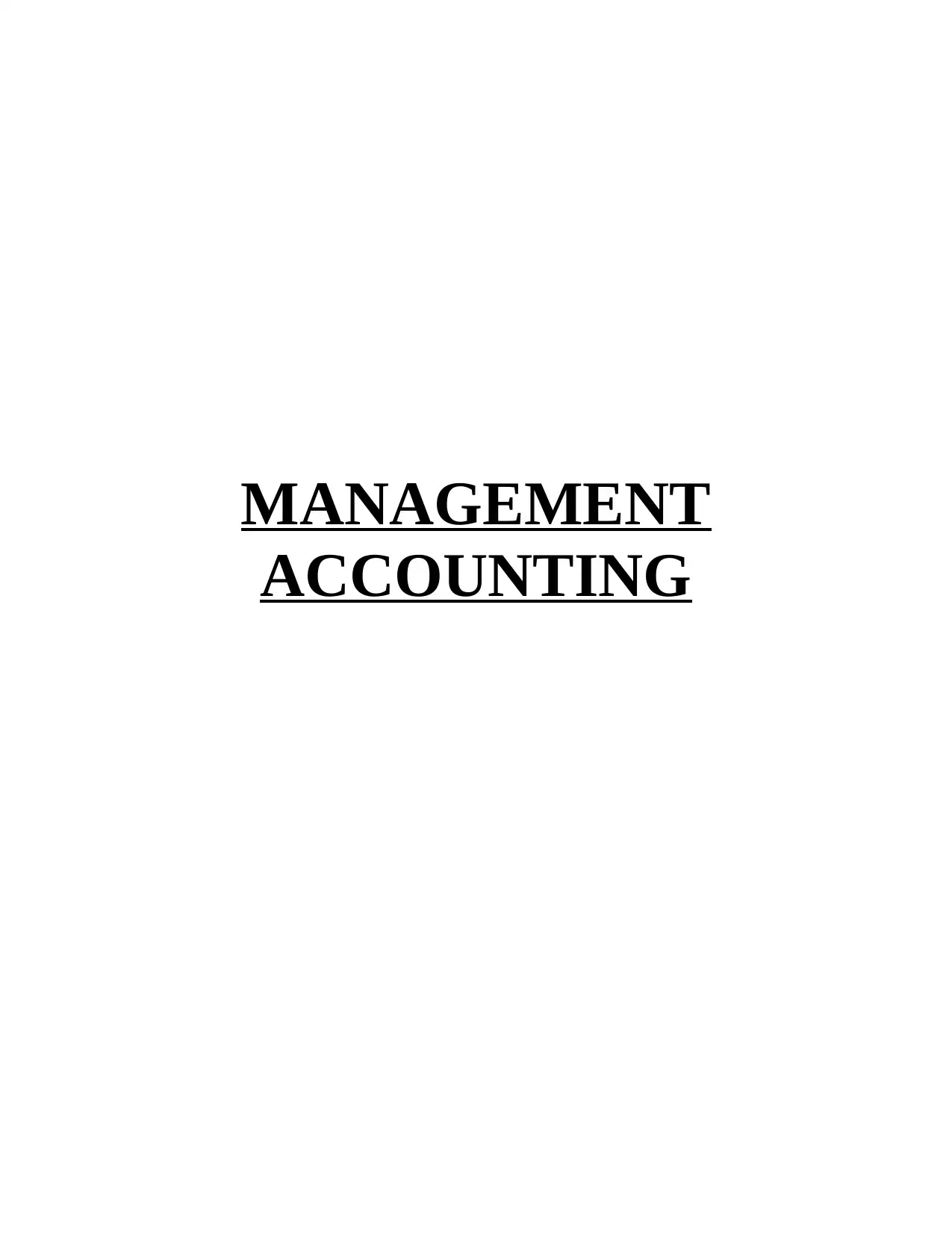
MANAGEMENT
ACCOUNTING
ACCOUNTING
Paraphrase This Document
Need a fresh take? Get an instant paraphrase of this document with our AI Paraphraser
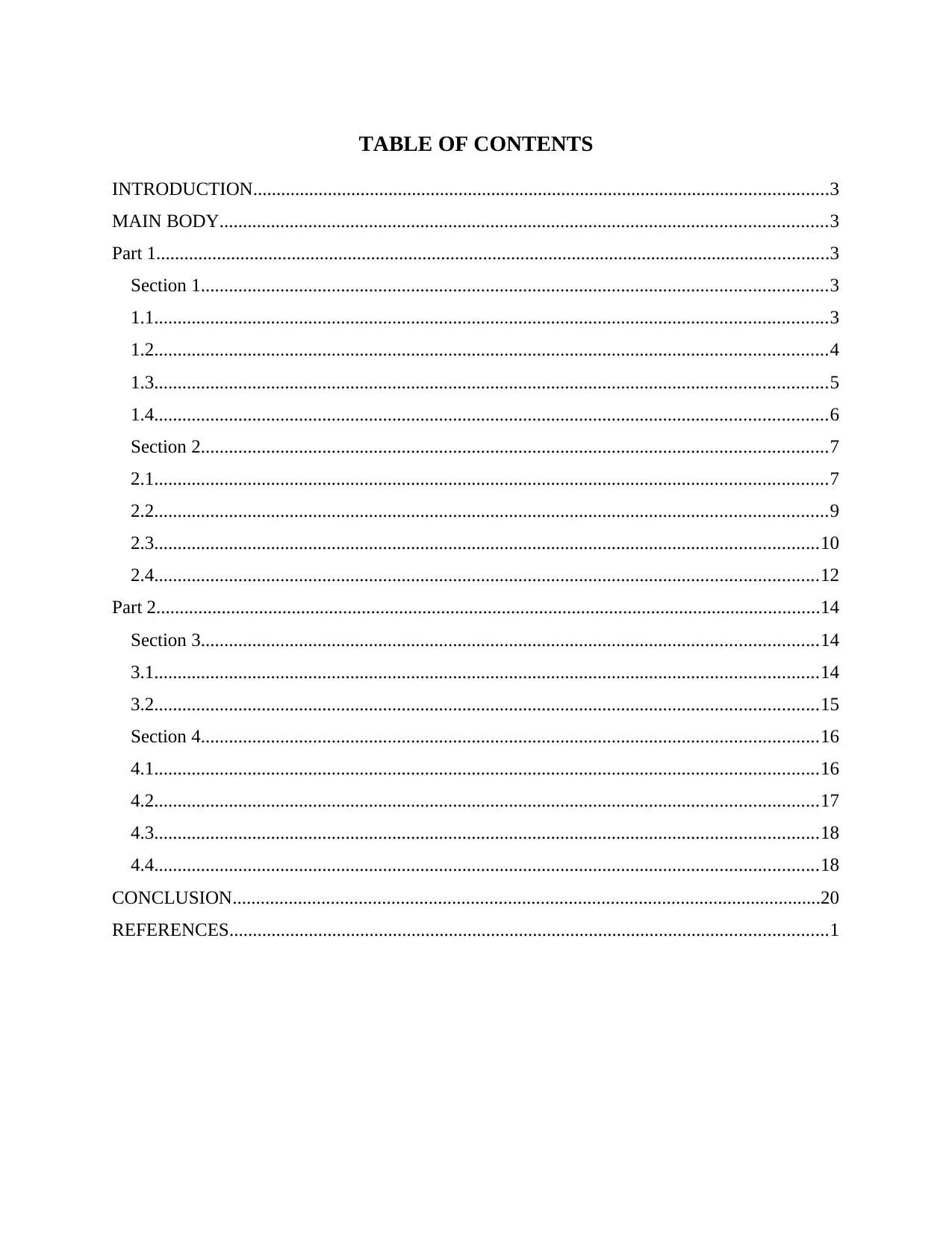
TABLE OF CONTENTS
INTRODUCTION...........................................................................................................................3
MAIN BODY..................................................................................................................................3
Part 1................................................................................................................................................3
Section 1......................................................................................................................................3
1.1................................................................................................................................................3
1.2................................................................................................................................................4
1.3................................................................................................................................................5
1.4................................................................................................................................................6
Section 2......................................................................................................................................7
2.1................................................................................................................................................7
2.2................................................................................................................................................9
2.3..............................................................................................................................................10
2.4..............................................................................................................................................12
Part 2..............................................................................................................................................14
Section 3....................................................................................................................................14
3.1..............................................................................................................................................14
3.2..............................................................................................................................................15
Section 4....................................................................................................................................16
4.1..............................................................................................................................................16
4.2..............................................................................................................................................17
4.3..............................................................................................................................................18
4.4..............................................................................................................................................18
CONCLUSION..............................................................................................................................20
REFERENCES................................................................................................................................1
INTRODUCTION...........................................................................................................................3
MAIN BODY..................................................................................................................................3
Part 1................................................................................................................................................3
Section 1......................................................................................................................................3
1.1................................................................................................................................................3
1.2................................................................................................................................................4
1.3................................................................................................................................................5
1.4................................................................................................................................................6
Section 2......................................................................................................................................7
2.1................................................................................................................................................7
2.2................................................................................................................................................9
2.3..............................................................................................................................................10
2.4..............................................................................................................................................12
Part 2..............................................................................................................................................14
Section 3....................................................................................................................................14
3.1..............................................................................................................................................14
3.2..............................................................................................................................................15
Section 4....................................................................................................................................16
4.1..............................................................................................................................................16
4.2..............................................................................................................................................17
4.3..............................................................................................................................................18
4.4..............................................................................................................................................18
CONCLUSION..............................................................................................................................20
REFERENCES................................................................................................................................1
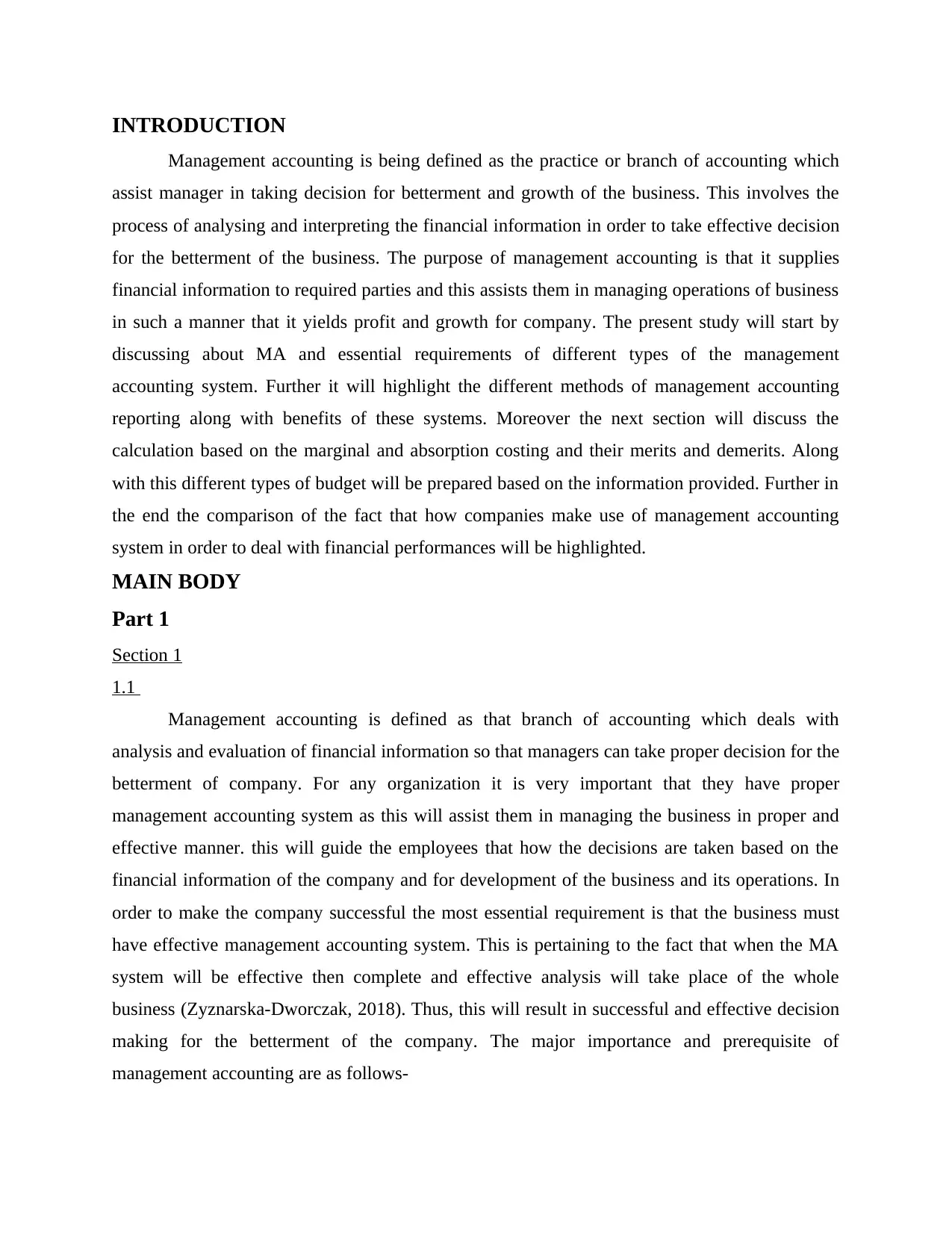
INTRODUCTION
Management accounting is being defined as the practice or branch of accounting which
assist manager in taking decision for betterment and growth of the business. This involves the
process of analysing and interpreting the financial information in order to take effective decision
for the betterment of the business. The purpose of management accounting is that it supplies
financial information to required parties and this assists them in managing operations of business
in such a manner that it yields profit and growth for company. The present study will start by
discussing about MA and essential requirements of different types of the management
accounting system. Further it will highlight the different methods of management accounting
reporting along with benefits of these systems. Moreover the next section will discuss the
calculation based on the marginal and absorption costing and their merits and demerits. Along
with this different types of budget will be prepared based on the information provided. Further in
the end the comparison of the fact that how companies make use of management accounting
system in order to deal with financial performances will be highlighted.
MAIN BODY
Part 1
Section 1
1.1
Management accounting is defined as that branch of accounting which deals with
analysis and evaluation of financial information so that managers can take proper decision for the
betterment of company. For any organization it is very important that they have proper
management accounting system as this will assist them in managing the business in proper and
effective manner. this will guide the employees that how the decisions are taken based on the
financial information of the company and for development of the business and its operations. In
order to make the company successful the most essential requirement is that the business must
have effective management accounting system. This is pertaining to the fact that when the MA
system will be effective then complete and effective analysis will take place of the whole
business (Zyznarska-Dworczak, 2018). Thus, this will result in successful and effective decision
making for the betterment of the company. The major importance and prerequisite of
management accounting are as follows-
Management accounting is being defined as the practice or branch of accounting which
assist manager in taking decision for betterment and growth of the business. This involves the
process of analysing and interpreting the financial information in order to take effective decision
for the betterment of the business. The purpose of management accounting is that it supplies
financial information to required parties and this assists them in managing operations of business
in such a manner that it yields profit and growth for company. The present study will start by
discussing about MA and essential requirements of different types of the management
accounting system. Further it will highlight the different methods of management accounting
reporting along with benefits of these systems. Moreover the next section will discuss the
calculation based on the marginal and absorption costing and their merits and demerits. Along
with this different types of budget will be prepared based on the information provided. Further in
the end the comparison of the fact that how companies make use of management accounting
system in order to deal with financial performances will be highlighted.
MAIN BODY
Part 1
Section 1
1.1
Management accounting is defined as that branch of accounting which deals with
analysis and evaluation of financial information so that managers can take proper decision for the
betterment of company. For any organization it is very important that they have proper
management accounting system as this will assist them in managing the business in proper and
effective manner. this will guide the employees that how the decisions are taken based on the
financial information of the company and for development of the business and its operations. In
order to make the company successful the most essential requirement is that the business must
have effective management accounting system. This is pertaining to the fact that when the MA
system will be effective then complete and effective analysis will take place of the whole
business (Zyznarska-Dworczak, 2018). Thus, this will result in successful and effective decision
making for the betterment of the company. The major importance and prerequisite of
management accounting are as follows-
⊘ This is a preview!⊘
Do you want full access?
Subscribe today to unlock all pages.

Trusted by 1+ million students worldwide
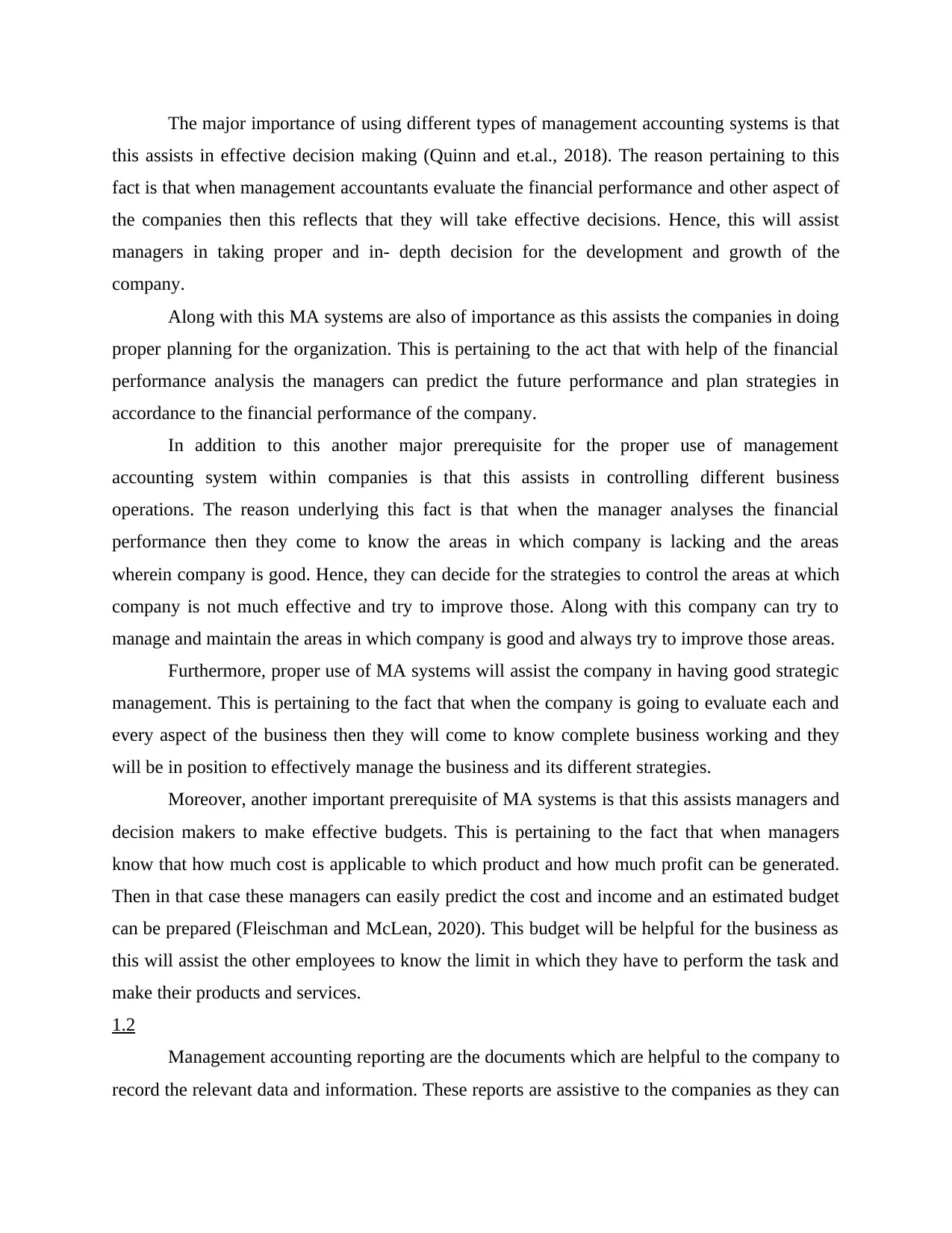
The major importance of using different types of management accounting systems is that
this assists in effective decision making (Quinn and et.al., 2018). The reason pertaining to this
fact is that when management accountants evaluate the financial performance and other aspect of
the companies then this reflects that they will take effective decisions. Hence, this will assist
managers in taking proper and in- depth decision for the development and growth of the
company.
Along with this MA systems are also of importance as this assists the companies in doing
proper planning for the organization. This is pertaining to the act that with help of the financial
performance analysis the managers can predict the future performance and plan strategies in
accordance to the financial performance of the company.
In addition to this another major prerequisite for the proper use of management
accounting system within companies is that this assists in controlling different business
operations. The reason underlying this fact is that when the manager analyses the financial
performance then they come to know the areas in which company is lacking and the areas
wherein company is good. Hence, they can decide for the strategies to control the areas at which
company is not much effective and try to improve those. Along with this company can try to
manage and maintain the areas in which company is good and always try to improve those areas.
Furthermore, proper use of MA systems will assist the company in having good strategic
management. This is pertaining to the fact that when the company is going to evaluate each and
every aspect of the business then they will come to know complete business working and they
will be in position to effectively manage the business and its different strategies.
Moreover, another important prerequisite of MA systems is that this assists managers and
decision makers to make effective budgets. This is pertaining to the fact that when managers
know that how much cost is applicable to which product and how much profit can be generated.
Then in that case these managers can easily predict the cost and income and an estimated budget
can be prepared (Fleischman and McLean, 2020). This budget will be helpful for the business as
this will assist the other employees to know the limit in which they have to perform the task and
make their products and services.
1.2
Management accounting reporting are the documents which are helpful to the company to
record the relevant data and information. These reports are assistive to the companies as they can
this assists in effective decision making (Quinn and et.al., 2018). The reason pertaining to this
fact is that when management accountants evaluate the financial performance and other aspect of
the companies then this reflects that they will take effective decisions. Hence, this will assist
managers in taking proper and in- depth decision for the development and growth of the
company.
Along with this MA systems are also of importance as this assists the companies in doing
proper planning for the organization. This is pertaining to the act that with help of the financial
performance analysis the managers can predict the future performance and plan strategies in
accordance to the financial performance of the company.
In addition to this another major prerequisite for the proper use of management
accounting system within companies is that this assists in controlling different business
operations. The reason underlying this fact is that when the manager analyses the financial
performance then they come to know the areas in which company is lacking and the areas
wherein company is good. Hence, they can decide for the strategies to control the areas at which
company is not much effective and try to improve those. Along with this company can try to
manage and maintain the areas in which company is good and always try to improve those areas.
Furthermore, proper use of MA systems will assist the company in having good strategic
management. This is pertaining to the fact that when the company is going to evaluate each and
every aspect of the business then they will come to know complete business working and they
will be in position to effectively manage the business and its different strategies.
Moreover, another important prerequisite of MA systems is that this assists managers and
decision makers to make effective budgets. This is pertaining to the fact that when managers
know that how much cost is applicable to which product and how much profit can be generated.
Then in that case these managers can easily predict the cost and income and an estimated budget
can be prepared (Fleischman and McLean, 2020). This budget will be helpful for the business as
this will assist the other employees to know the limit in which they have to perform the task and
make their products and services.
1.2
Management accounting reporting are the documents which are helpful to the company to
record the relevant data and information. These reports are assistive to the companies as they can
Paraphrase This Document
Need a fresh take? Get an instant paraphrase of this document with our AI Paraphraser
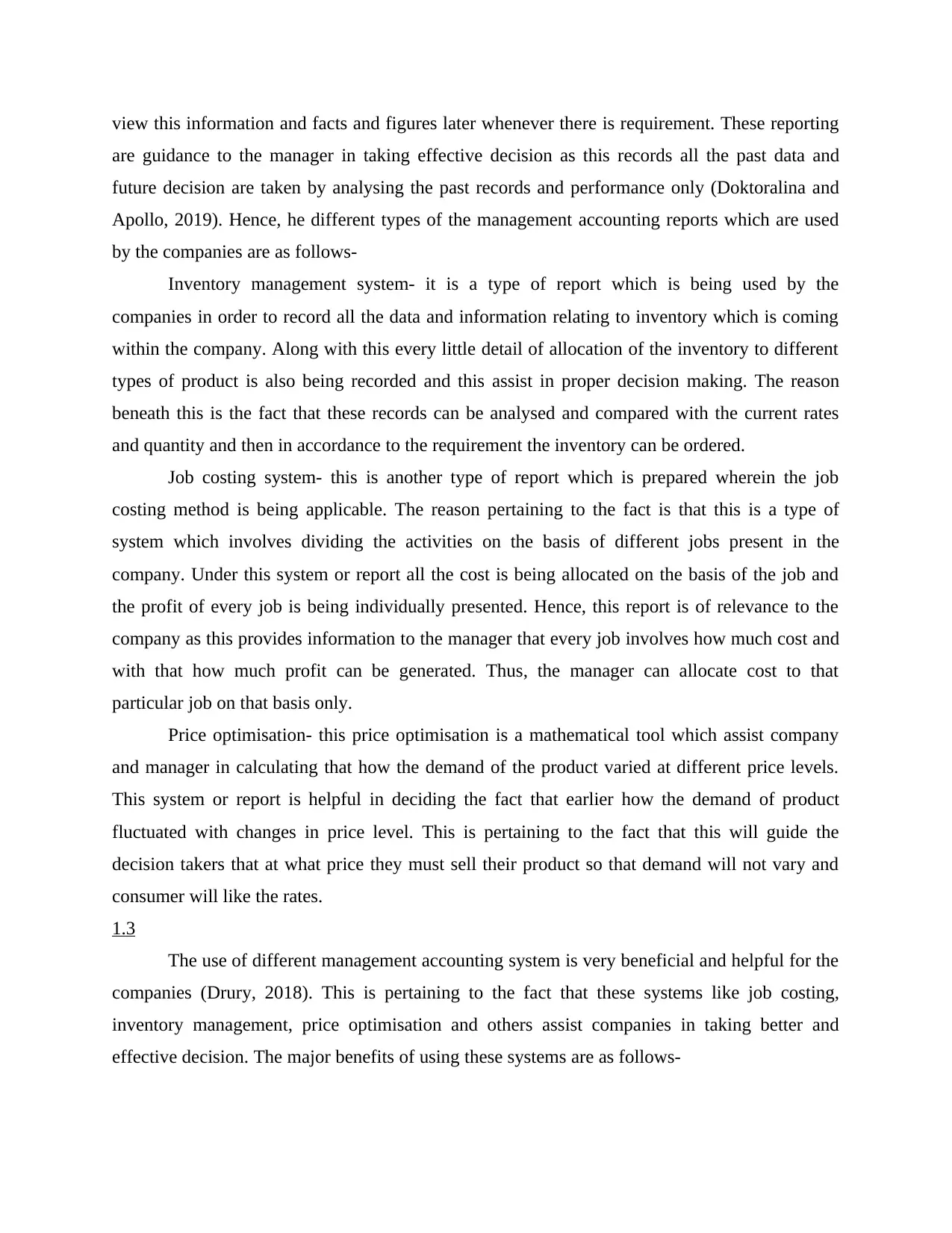
view this information and facts and figures later whenever there is requirement. These reporting
are guidance to the manager in taking effective decision as this records all the past data and
future decision are taken by analysing the past records and performance only (Doktoralina and
Apollo, 2019). Hence, he different types of the management accounting reports which are used
by the companies are as follows-
Inventory management system- it is a type of report which is being used by the
companies in order to record all the data and information relating to inventory which is coming
within the company. Along with this every little detail of allocation of the inventory to different
types of product is also being recorded and this assist in proper decision making. The reason
beneath this is the fact that these records can be analysed and compared with the current rates
and quantity and then in accordance to the requirement the inventory can be ordered.
Job costing system- this is another type of report which is prepared wherein the job
costing method is being applicable. The reason pertaining to the fact is that this is a type of
system which involves dividing the activities on the basis of different jobs present in the
company. Under this system or report all the cost is being allocated on the basis of the job and
the profit of every job is being individually presented. Hence, this report is of relevance to the
company as this provides information to the manager that every job involves how much cost and
with that how much profit can be generated. Thus, the manager can allocate cost to that
particular job on that basis only.
Price optimisation- this price optimisation is a mathematical tool which assist company
and manager in calculating that how the demand of the product varied at different price levels.
This system or report is helpful in deciding the fact that earlier how the demand of product
fluctuated with changes in price level. This is pertaining to the fact that this will guide the
decision takers that at what price they must sell their product so that demand will not vary and
consumer will like the rates.
1.3
The use of different management accounting system is very beneficial and helpful for the
companies (Drury, 2018). This is pertaining to the fact that these systems like job costing,
inventory management, price optimisation and others assist companies in taking better and
effective decision. The major benefits of using these systems are as follows-
are guidance to the manager in taking effective decision as this records all the past data and
future decision are taken by analysing the past records and performance only (Doktoralina and
Apollo, 2019). Hence, he different types of the management accounting reports which are used
by the companies are as follows-
Inventory management system- it is a type of report which is being used by the
companies in order to record all the data and information relating to inventory which is coming
within the company. Along with this every little detail of allocation of the inventory to different
types of product is also being recorded and this assist in proper decision making. The reason
beneath this is the fact that these records can be analysed and compared with the current rates
and quantity and then in accordance to the requirement the inventory can be ordered.
Job costing system- this is another type of report which is prepared wherein the job
costing method is being applicable. The reason pertaining to the fact is that this is a type of
system which involves dividing the activities on the basis of different jobs present in the
company. Under this system or report all the cost is being allocated on the basis of the job and
the profit of every job is being individually presented. Hence, this report is of relevance to the
company as this provides information to the manager that every job involves how much cost and
with that how much profit can be generated. Thus, the manager can allocate cost to that
particular job on that basis only.
Price optimisation- this price optimisation is a mathematical tool which assist company
and manager in calculating that how the demand of the product varied at different price levels.
This system or report is helpful in deciding the fact that earlier how the demand of product
fluctuated with changes in price level. This is pertaining to the fact that this will guide the
decision takers that at what price they must sell their product so that demand will not vary and
consumer will like the rates.
1.3
The use of different management accounting system is very beneficial and helpful for the
companies (Drury, 2018). This is pertaining to the fact that these systems like job costing,
inventory management, price optimisation and others assist companies in taking better and
effective decision. The major benefits of using these systems are as follows-
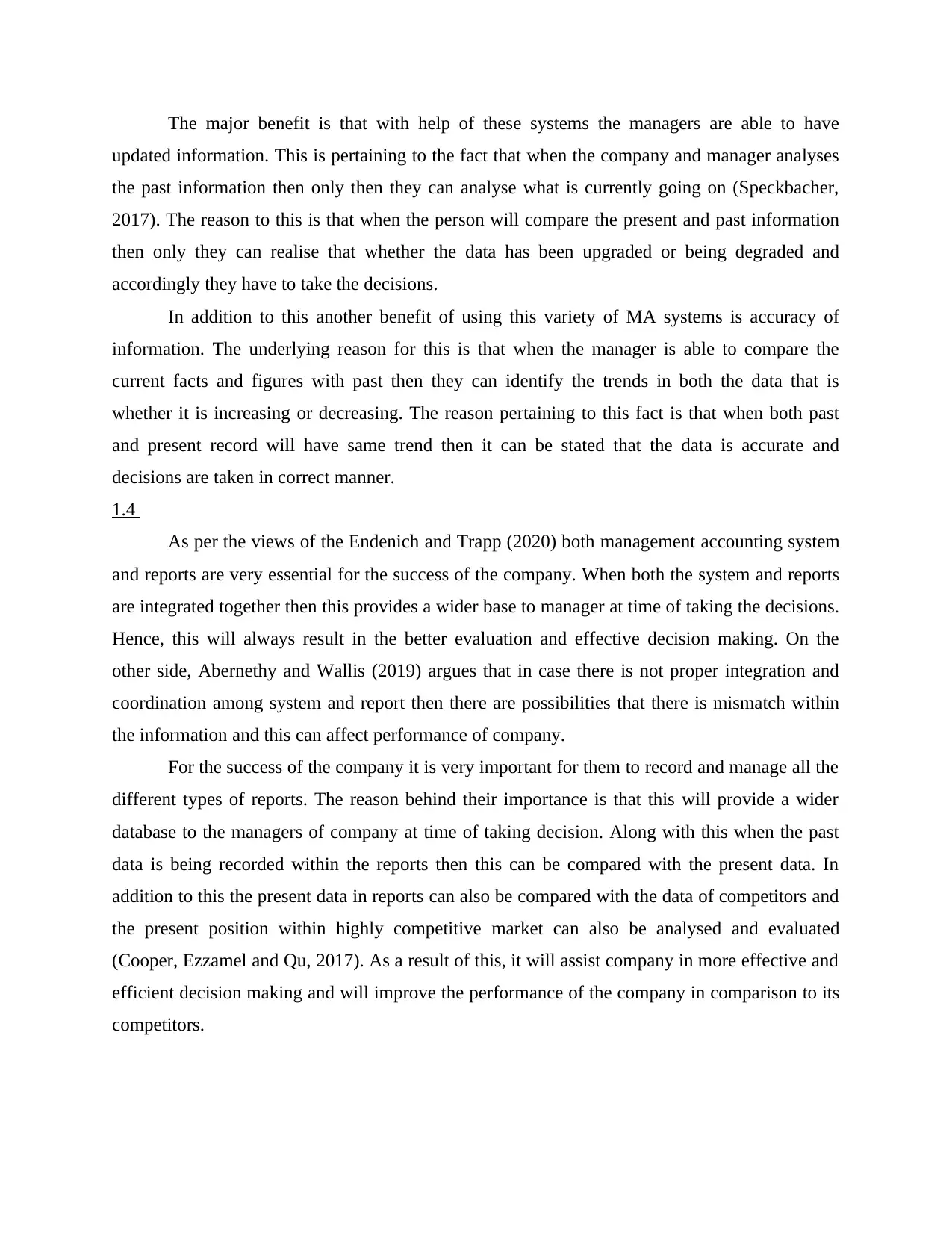
The major benefit is that with help of these systems the managers are able to have
updated information. This is pertaining to the fact that when the company and manager analyses
the past information then only then they can analyse what is currently going on (Speckbacher,
2017). The reason to this is that when the person will compare the present and past information
then only they can realise that whether the data has been upgraded or being degraded and
accordingly they have to take the decisions.
In addition to this another benefit of using this variety of MA systems is accuracy of
information. The underlying reason for this is that when the manager is able to compare the
current facts and figures with past then they can identify the trends in both the data that is
whether it is increasing or decreasing. The reason pertaining to this fact is that when both past
and present record will have same trend then it can be stated that the data is accurate and
decisions are taken in correct manner.
1.4
As per the views of the Endenich and Trapp (2020) both management accounting system
and reports are very essential for the success of the company. When both the system and reports
are integrated together then this provides a wider base to manager at time of taking the decisions.
Hence, this will always result in the better evaluation and effective decision making. On the
other side, Abernethy and Wallis (2019) argues that in case there is not proper integration and
coordination among system and report then there are possibilities that there is mismatch within
the information and this can affect performance of company.
For the success of the company it is very important for them to record and manage all the
different types of reports. The reason behind their importance is that this will provide a wider
database to the managers of company at time of taking decision. Along with this when the past
data is being recorded within the reports then this can be compared with the present data. In
addition to this the present data in reports can also be compared with the data of competitors and
the present position within highly competitive market can also be analysed and evaluated
(Cooper, Ezzamel and Qu, 2017). As a result of this, it will assist company in more effective and
efficient decision making and will improve the performance of the company in comparison to its
competitors.
updated information. This is pertaining to the fact that when the company and manager analyses
the past information then only then they can analyse what is currently going on (Speckbacher,
2017). The reason to this is that when the person will compare the present and past information
then only they can realise that whether the data has been upgraded or being degraded and
accordingly they have to take the decisions.
In addition to this another benefit of using this variety of MA systems is accuracy of
information. The underlying reason for this is that when the manager is able to compare the
current facts and figures with past then they can identify the trends in both the data that is
whether it is increasing or decreasing. The reason pertaining to this fact is that when both past
and present record will have same trend then it can be stated that the data is accurate and
decisions are taken in correct manner.
1.4
As per the views of the Endenich and Trapp (2020) both management accounting system
and reports are very essential for the success of the company. When both the system and reports
are integrated together then this provides a wider base to manager at time of taking the decisions.
Hence, this will always result in the better evaluation and effective decision making. On the
other side, Abernethy and Wallis (2019) argues that in case there is not proper integration and
coordination among system and report then there are possibilities that there is mismatch within
the information and this can affect performance of company.
For the success of the company it is very important for them to record and manage all the
different types of reports. The reason behind their importance is that this will provide a wider
database to the managers of company at time of taking decision. Along with this when the past
data is being recorded within the reports then this can be compared with the present data. In
addition to this the present data in reports can also be compared with the data of competitors and
the present position within highly competitive market can also be analysed and evaluated
(Cooper, Ezzamel and Qu, 2017). As a result of this, it will assist company in more effective and
efficient decision making and will improve the performance of the company in comparison to its
competitors.
⊘ This is a preview!⊘
Do you want full access?
Subscribe today to unlock all pages.

Trusted by 1+ million students worldwide
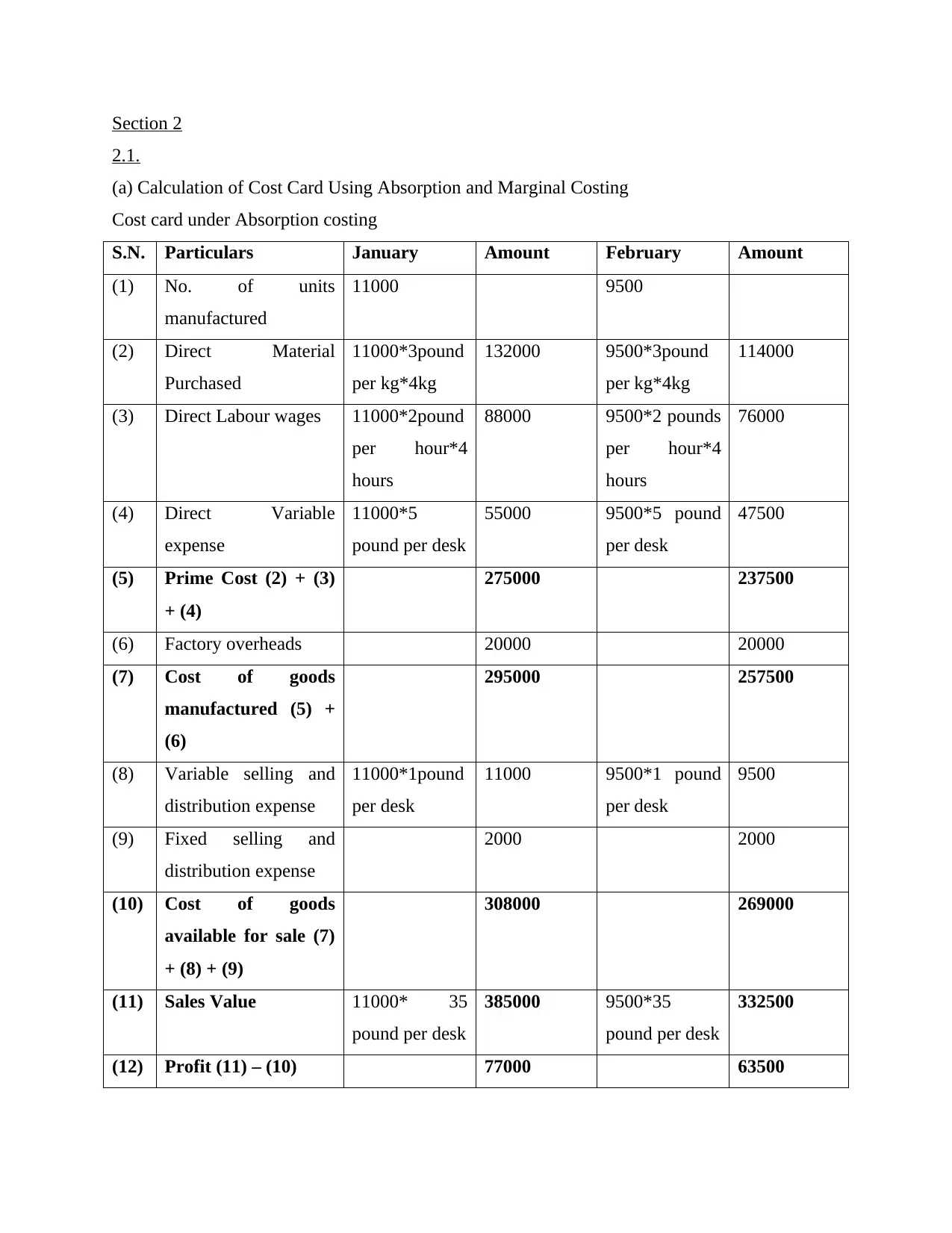
Section 2
2.1.
(a) Calculation of Cost Card Using Absorption and Marginal Costing
Cost card under Absorption costing
S.N. Particulars January Amount February Amount
(1) No. of units
manufactured
11000 9500
(2) Direct Material
Purchased
11000*3pound
per kg*4kg
132000 9500*3pound
per kg*4kg
114000
(3) Direct Labour wages 11000*2pound
per hour*4
hours
88000 9500*2 pounds
per hour*4
hours
76000
(4) Direct Variable
expense
11000*5
pound per desk
55000 9500*5 pound
per desk
47500
(5) Prime Cost (2) + (3)
+ (4)
275000 237500
(6) Factory overheads 20000 20000
(7) Cost of goods
manufactured (5) +
(6)
295000 257500
(8) Variable selling and
distribution expense
11000*1pound
per desk
11000 9500*1 pound
per desk
9500
(9) Fixed selling and
distribution expense
2000 2000
(10) Cost of goods
available for sale (7)
+ (8) + (9)
308000 269000
(11) Sales Value 11000* 35
pound per desk
385000 9500*35
pound per desk
332500
(12) Profit (11) – (10) 77000 63500
2.1.
(a) Calculation of Cost Card Using Absorption and Marginal Costing
Cost card under Absorption costing
S.N. Particulars January Amount February Amount
(1) No. of units
manufactured
11000 9500
(2) Direct Material
Purchased
11000*3pound
per kg*4kg
132000 9500*3pound
per kg*4kg
114000
(3) Direct Labour wages 11000*2pound
per hour*4
hours
88000 9500*2 pounds
per hour*4
hours
76000
(4) Direct Variable
expense
11000*5
pound per desk
55000 9500*5 pound
per desk
47500
(5) Prime Cost (2) + (3)
+ (4)
275000 237500
(6) Factory overheads 20000 20000
(7) Cost of goods
manufactured (5) +
(6)
295000 257500
(8) Variable selling and
distribution expense
11000*1pound
per desk
11000 9500*1 pound
per desk
9500
(9) Fixed selling and
distribution expense
2000 2000
(10) Cost of goods
available for sale (7)
+ (8) + (9)
308000 269000
(11) Sales Value 11000* 35
pound per desk
385000 9500*35
pound per desk
332500
(12) Profit (11) – (10) 77000 63500
Paraphrase This Document
Need a fresh take? Get an instant paraphrase of this document with our AI Paraphraser
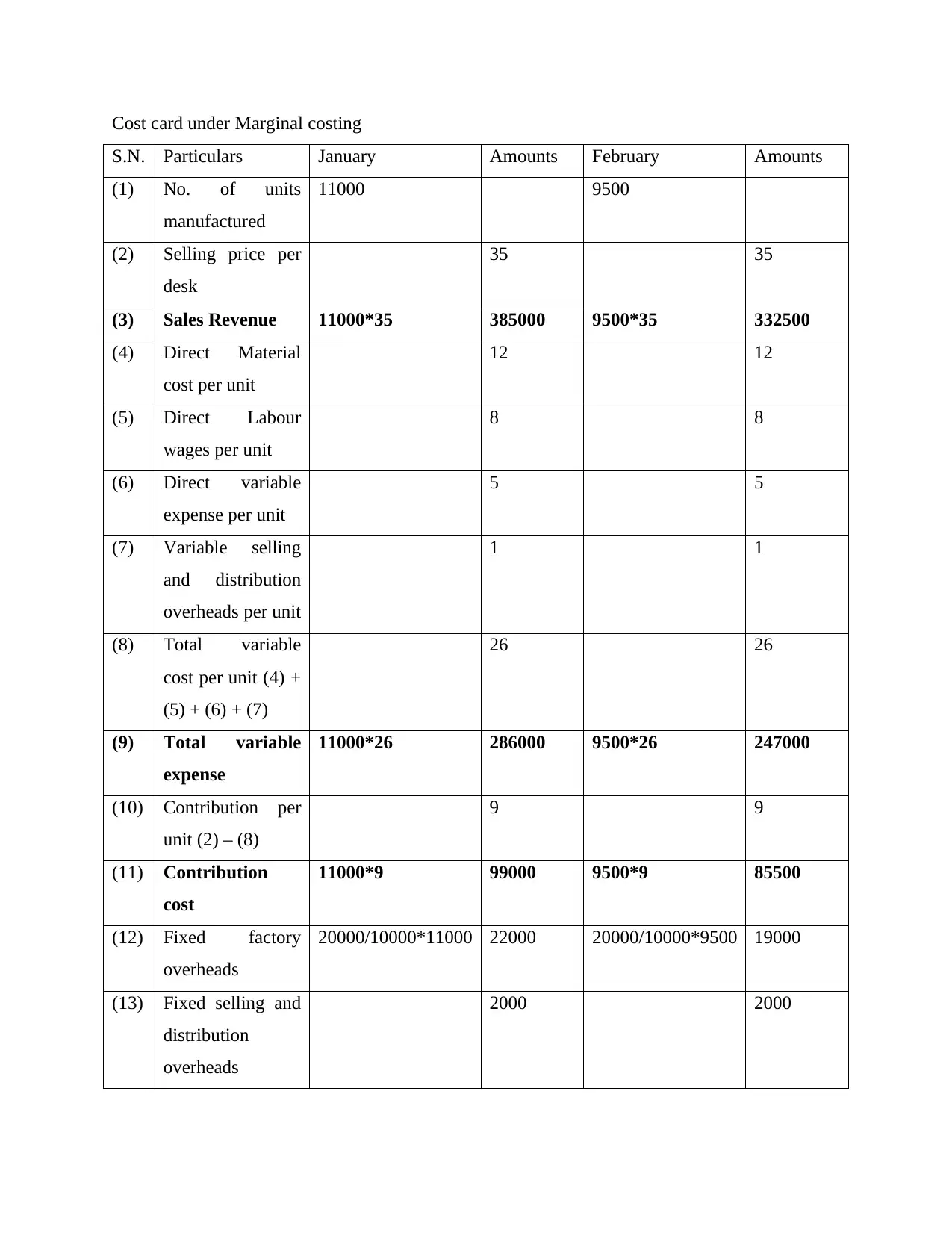
Cost card under Marginal costing
S.N. Particulars January Amounts February Amounts
(1) No. of units
manufactured
11000 9500
(2) Selling price per
desk
35 35
(3) Sales Revenue 11000*35 385000 9500*35 332500
(4) Direct Material
cost per unit
12 12
(5) Direct Labour
wages per unit
8 8
(6) Direct variable
expense per unit
5 5
(7) Variable selling
and distribution
overheads per unit
1 1
(8) Total variable
cost per unit (4) +
(5) + (6) + (7)
26 26
(9) Total variable
expense
11000*26 286000 9500*26 247000
(10) Contribution per
unit (2) – (8)
9 9
(11) Contribution
cost
11000*9 99000 9500*9 85500
(12) Fixed factory
overheads
20000/10000*11000 22000 20000/10000*9500 19000
(13) Fixed selling and
distribution
overheads
2000 2000
S.N. Particulars January Amounts February Amounts
(1) No. of units
manufactured
11000 9500
(2) Selling price per
desk
35 35
(3) Sales Revenue 11000*35 385000 9500*35 332500
(4) Direct Material
cost per unit
12 12
(5) Direct Labour
wages per unit
8 8
(6) Direct variable
expense per unit
5 5
(7) Variable selling
and distribution
overheads per unit
1 1
(8) Total variable
cost per unit (4) +
(5) + (6) + (7)
26 26
(9) Total variable
expense
11000*26 286000 9500*26 247000
(10) Contribution per
unit (2) – (8)
9 9
(11) Contribution
cost
11000*9 99000 9500*9 85500
(12) Fixed factory
overheads
20000/10000*11000 22000 20000/10000*9500 19000
(13) Fixed selling and
distribution
overheads
2000 2000
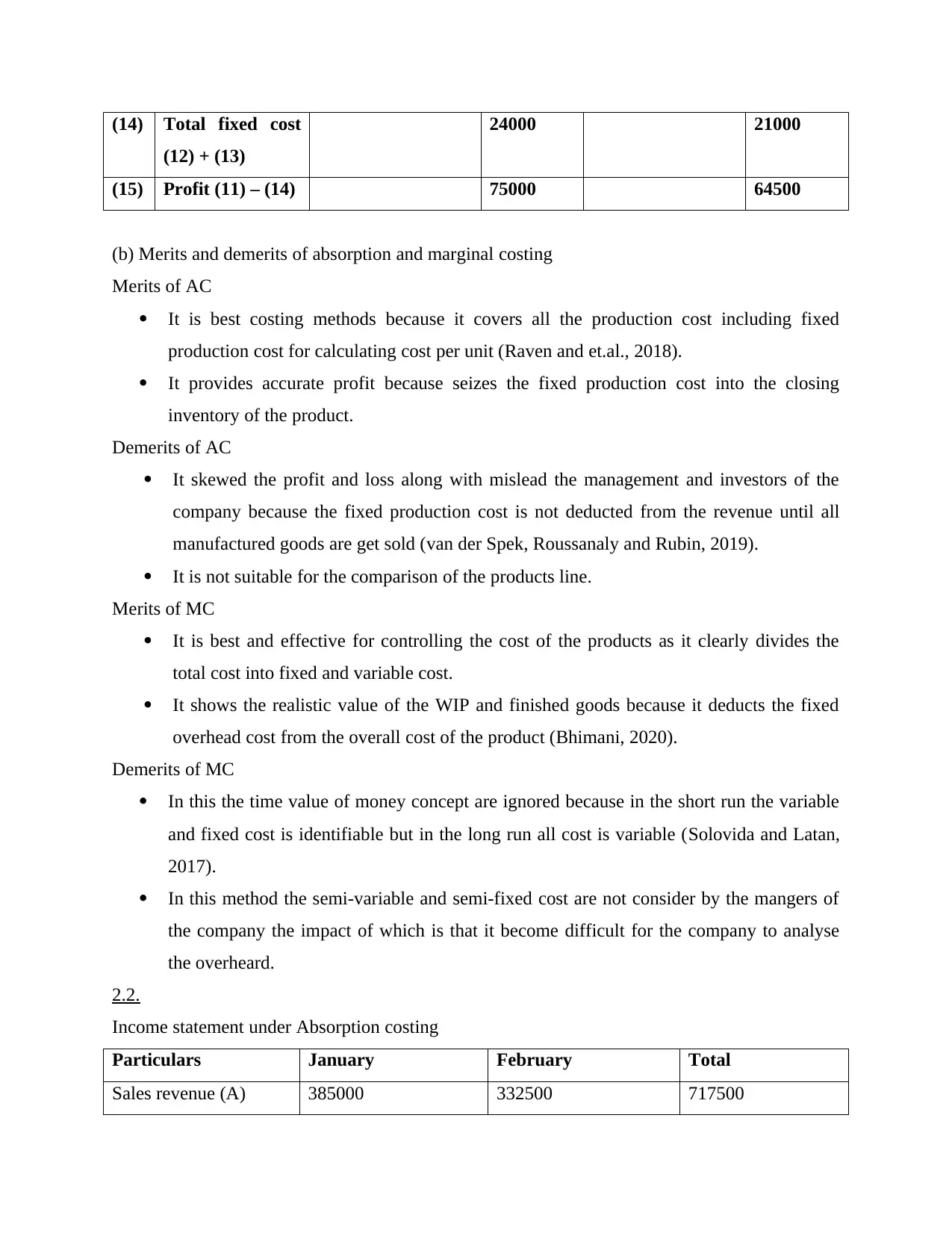
(14) Total fixed cost
(12) + (13)
24000 21000
(15) Profit (11) – (14) 75000 64500
(b) Merits and demerits of absorption and marginal costing
Merits of AC
It is best costing methods because it covers all the production cost including fixed
production cost for calculating cost per unit (Raven and et.al., 2018).
It provides accurate profit because seizes the fixed production cost into the closing
inventory of the product.
Demerits of AC
It skewed the profit and loss along with mislead the management and investors of the
company because the fixed production cost is not deducted from the revenue until all
manufactured goods are get sold (van der Spek, Roussanaly and Rubin, 2019).
It is not suitable for the comparison of the products line.
Merits of MC
It is best and effective for controlling the cost of the products as it clearly divides the
total cost into fixed and variable cost.
It shows the realistic value of the WIP and finished goods because it deducts the fixed
overhead cost from the overall cost of the product (Bhimani, 2020).
Demerits of MC
In this the time value of money concept are ignored because in the short run the variable
and fixed cost is identifiable but in the long run all cost is variable (Solovida and Latan,
2017).
In this method the semi-variable and semi-fixed cost are not consider by the mangers of
the company the impact of which is that it become difficult for the company to analyse
the overheard.
2.2.
Income statement under Absorption costing
Particulars January February Total
Sales revenue (A) 385000 332500 717500
(12) + (13)
24000 21000
(15) Profit (11) – (14) 75000 64500
(b) Merits and demerits of absorption and marginal costing
Merits of AC
It is best costing methods because it covers all the production cost including fixed
production cost for calculating cost per unit (Raven and et.al., 2018).
It provides accurate profit because seizes the fixed production cost into the closing
inventory of the product.
Demerits of AC
It skewed the profit and loss along with mislead the management and investors of the
company because the fixed production cost is not deducted from the revenue until all
manufactured goods are get sold (van der Spek, Roussanaly and Rubin, 2019).
It is not suitable for the comparison of the products line.
Merits of MC
It is best and effective for controlling the cost of the products as it clearly divides the
total cost into fixed and variable cost.
It shows the realistic value of the WIP and finished goods because it deducts the fixed
overhead cost from the overall cost of the product (Bhimani, 2020).
Demerits of MC
In this the time value of money concept are ignored because in the short run the variable
and fixed cost is identifiable but in the long run all cost is variable (Solovida and Latan,
2017).
In this method the semi-variable and semi-fixed cost are not consider by the mangers of
the company the impact of which is that it become difficult for the company to analyse
the overheard.
2.2.
Income statement under Absorption costing
Particulars January February Total
Sales revenue (A) 385000 332500 717500
⊘ This is a preview!⊘
Do you want full access?
Subscribe today to unlock all pages.

Trusted by 1+ million students worldwide
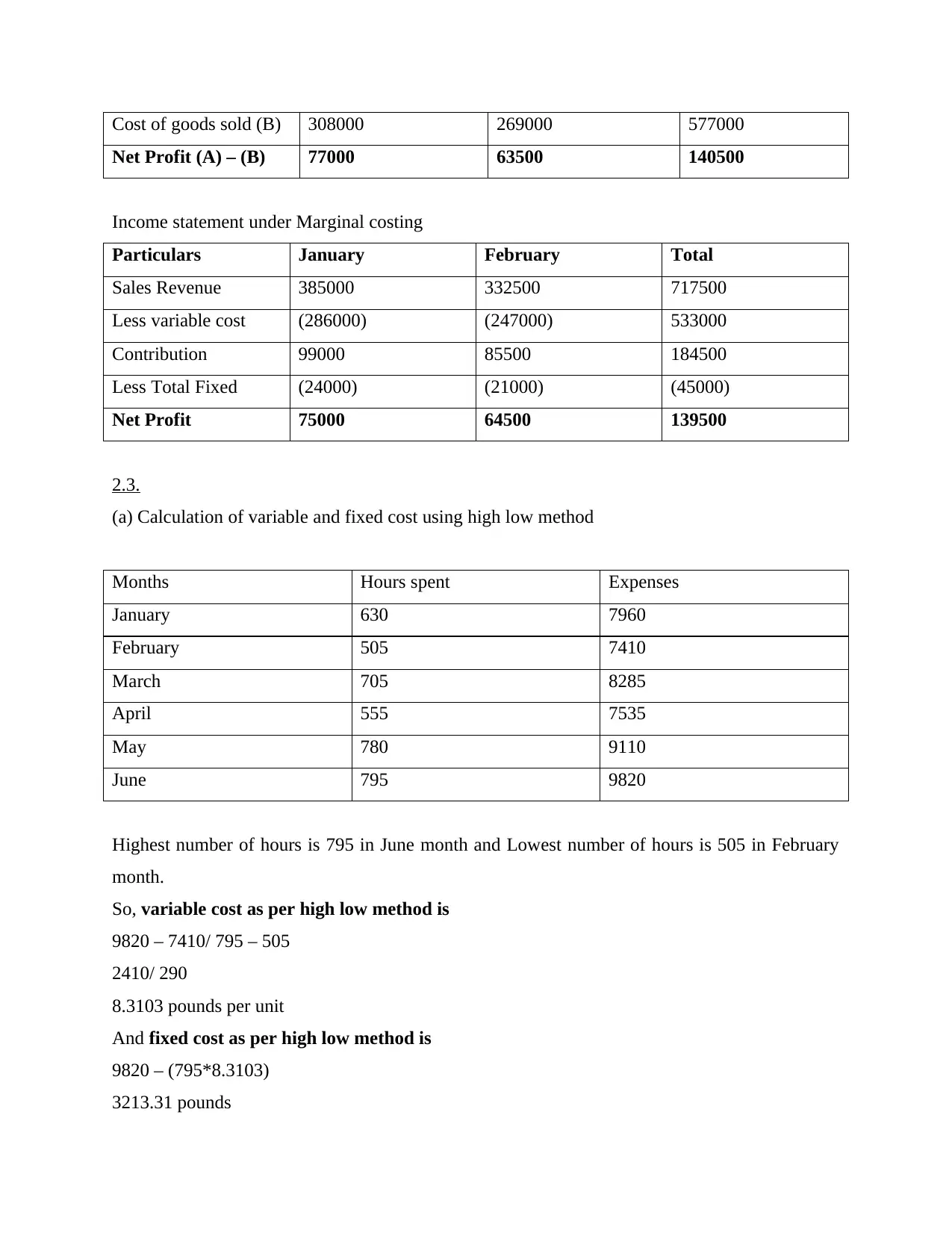
Cost of goods sold (B) 308000 269000 577000
Net Profit (A) – (B) 77000 63500 140500
Income statement under Marginal costing
Particulars January February Total
Sales Revenue 385000 332500 717500
Less variable cost (286000) (247000) 533000
Contribution 99000 85500 184500
Less Total Fixed (24000) (21000) (45000)
Net Profit 75000 64500 139500
2.3.
(a) Calculation of variable and fixed cost using high low method
Months Hours spent Expenses
January 630 7960
February 505 7410
March 705 8285
April 555 7535
May 780 9110
June 795 9820
Highest number of hours is 795 in June month and Lowest number of hours is 505 in February
month.
So, variable cost as per high low method is
9820 – 7410/ 795 – 505
2410/ 290
8.3103 pounds per unit
And fixed cost as per high low method is
9820 – (795*8.3103)
3213.31 pounds
Net Profit (A) – (B) 77000 63500 140500
Income statement under Marginal costing
Particulars January February Total
Sales Revenue 385000 332500 717500
Less variable cost (286000) (247000) 533000
Contribution 99000 85500 184500
Less Total Fixed (24000) (21000) (45000)
Net Profit 75000 64500 139500
2.3.
(a) Calculation of variable and fixed cost using high low method
Months Hours spent Expenses
January 630 7960
February 505 7410
March 705 8285
April 555 7535
May 780 9110
June 795 9820
Highest number of hours is 795 in June month and Lowest number of hours is 505 in February
month.
So, variable cost as per high low method is
9820 – 7410/ 795 – 505
2410/ 290
8.3103 pounds per unit
And fixed cost as per high low method is
9820 – (795*8.3103)
3213.31 pounds
Paraphrase This Document
Need a fresh take? Get an instant paraphrase of this document with our AI Paraphraser
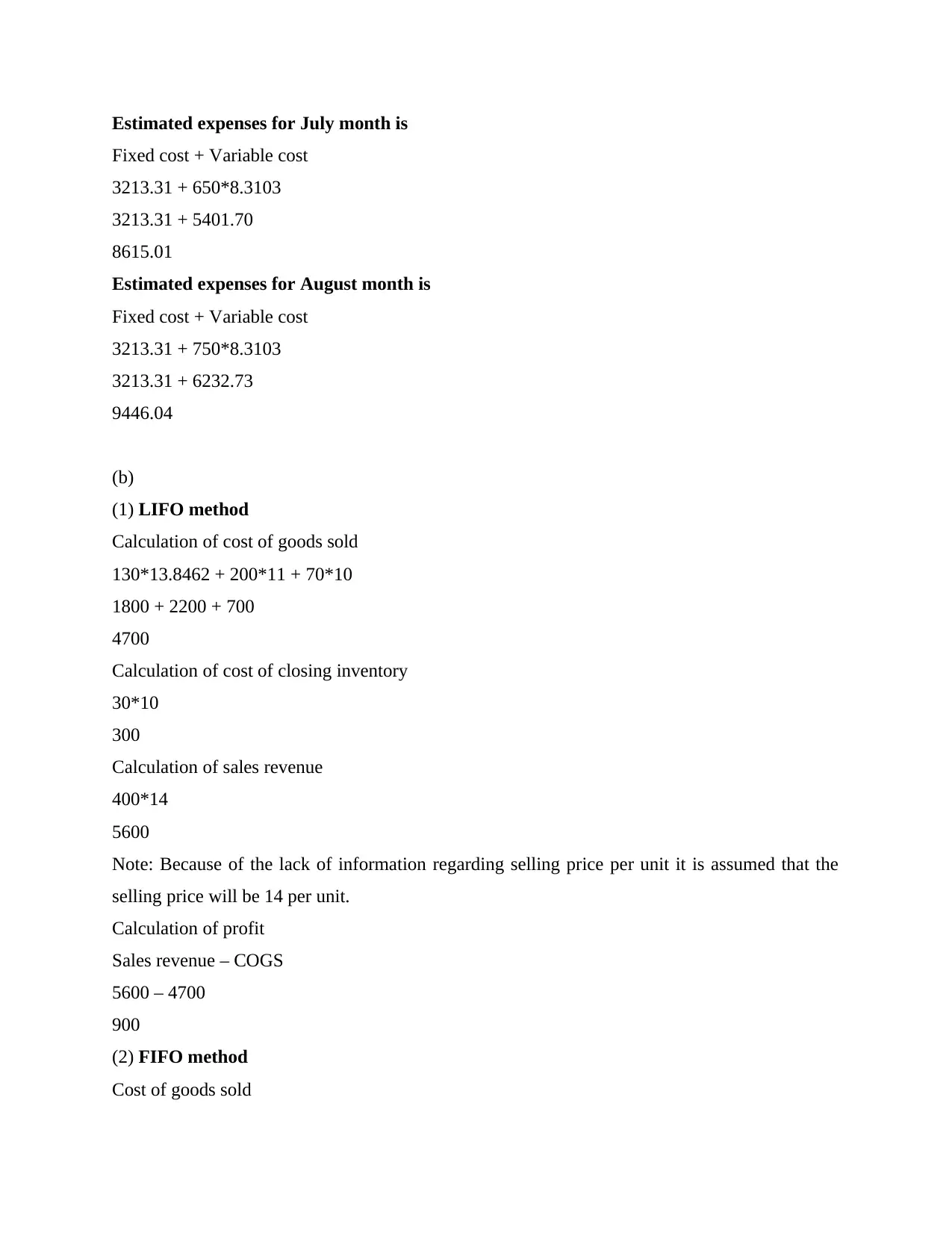
Estimated expenses for July month is
Fixed cost + Variable cost
3213.31 + 650*8.3103
3213.31 + 5401.70
8615.01
Estimated expenses for August month is
Fixed cost + Variable cost
3213.31 + 750*8.3103
3213.31 + 6232.73
9446.04
(b)
(1) LIFO method
Calculation of cost of goods sold
130*13.8462 + 200*11 + 70*10
1800 + 2200 + 700
4700
Calculation of cost of closing inventory
30*10
300
Calculation of sales revenue
400*14
5600
Note: Because of the lack of information regarding selling price per unit it is assumed that the
selling price will be 14 per unit.
Calculation of profit
Sales revenue – COGS
5600 – 4700
900
(2) FIFO method
Cost of goods sold
Fixed cost + Variable cost
3213.31 + 650*8.3103
3213.31 + 5401.70
8615.01
Estimated expenses for August month is
Fixed cost + Variable cost
3213.31 + 750*8.3103
3213.31 + 6232.73
9446.04
(b)
(1) LIFO method
Calculation of cost of goods sold
130*13.8462 + 200*11 + 70*10
1800 + 2200 + 700
4700
Calculation of cost of closing inventory
30*10
300
Calculation of sales revenue
400*14
5600
Note: Because of the lack of information regarding selling price per unit it is assumed that the
selling price will be 14 per unit.
Calculation of profit
Sales revenue – COGS
5600 – 4700
900
(2) FIFO method
Cost of goods sold
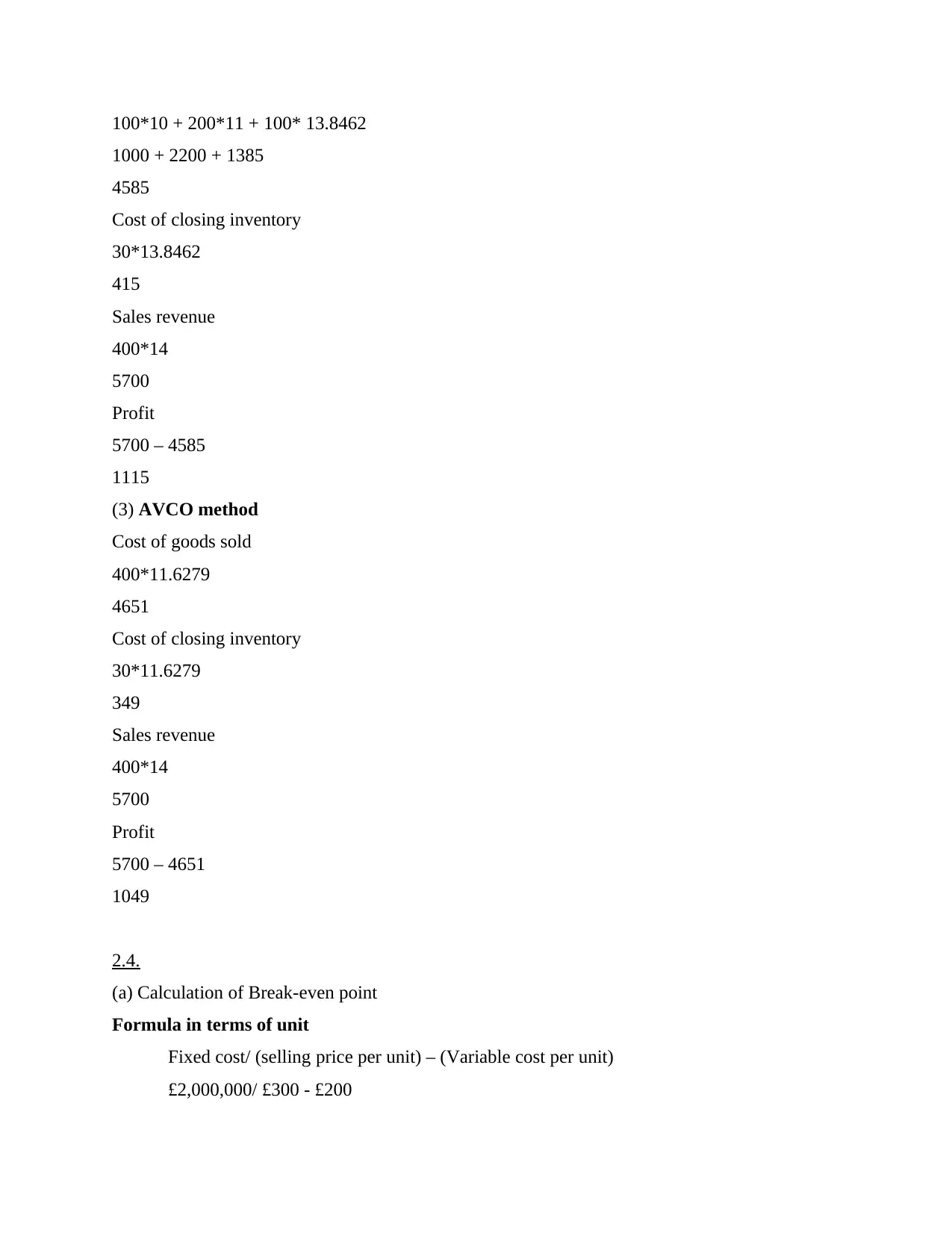
100*10 + 200*11 + 100* 13.8462
1000 + 2200 + 1385
4585
Cost of closing inventory
30*13.8462
415
Sales revenue
400*14
5700
Profit
5700 – 4585
1115
(3) AVCO method
Cost of goods sold
400*11.6279
4651
Cost of closing inventory
30*11.6279
349
Sales revenue
400*14
5700
Profit
5700 – 4651
1049
2.4.
(a) Calculation of Break-even point
Formula in terms of unit
Fixed cost/ (selling price per unit) – (Variable cost per unit)
£2,000,000/ £300 - £200
1000 + 2200 + 1385
4585
Cost of closing inventory
30*13.8462
415
Sales revenue
400*14
5700
Profit
5700 – 4585
1115
(3) AVCO method
Cost of goods sold
400*11.6279
4651
Cost of closing inventory
30*11.6279
349
Sales revenue
400*14
5700
Profit
5700 – 4651
1049
2.4.
(a) Calculation of Break-even point
Formula in terms of unit
Fixed cost/ (selling price per unit) – (Variable cost per unit)
£2,000,000/ £300 - £200
⊘ This is a preview!⊘
Do you want full access?
Subscribe today to unlock all pages.

Trusted by 1+ million students worldwide
1 out of 23
Related Documents
Your All-in-One AI-Powered Toolkit for Academic Success.
+13062052269
info@desklib.com
Available 24*7 on WhatsApp / Email
![[object Object]](/_next/static/media/star-bottom.7253800d.svg)
Unlock your academic potential
Copyright © 2020–2025 A2Z Services. All Rights Reserved. Developed and managed by ZUCOL.





